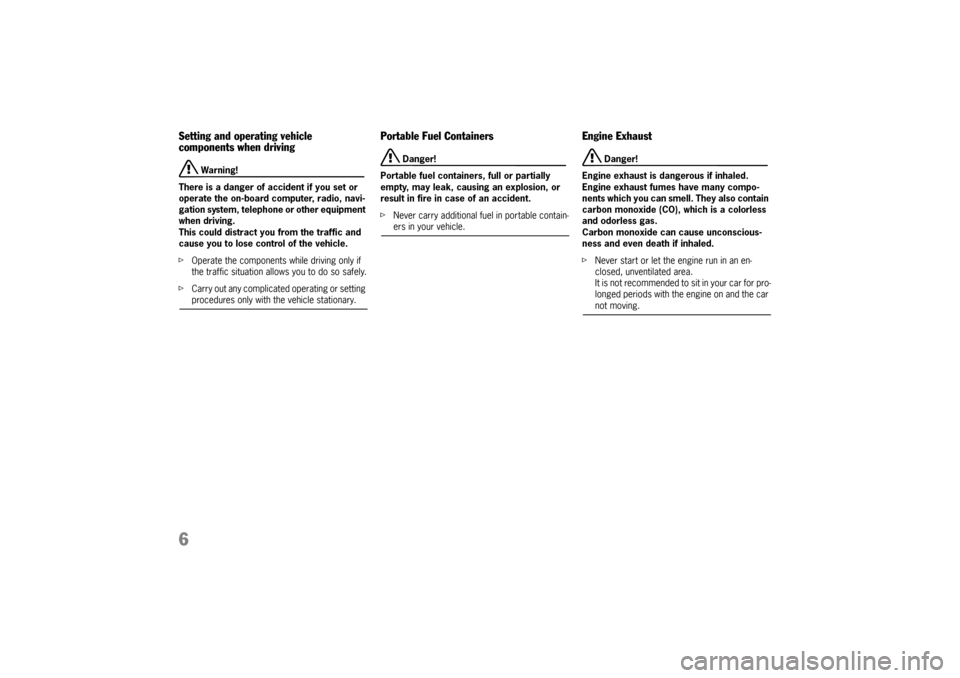PORSCHE CAYNNE TURBO 2006 1.G Owners Manual
Manufacturer: PORSCHE, Model Year: 2006, Model line: CAYENNE TURBO, Model: PORSCHE CAYENNE TURBO 2006 1.GPages: 387, PDF Size: 8.44 MB
Page 1 of 387

© Dr. Ing. h.c. F. Porsche AG
Porsche, the Porsche crest, Cayenne, Tiptronic
and Tequipment are registered trademarks and
the distinctive shapes of Porsche automobiles are
trademarks of Dr. Ing. h.c. F. Porsche AG.
All rights reserved.
Printed in Germany WKD 948 121 06 4/05
Page 2 of 387

2Dear Owner,We would like to thank you for your purchase of a
Porsche Cayenne.
Judging by the car you have chosen, you are a mo-
torist of a special breed, and you are probably no
novice when it comes to automobiles.
Remember however, as with any vehicle, you
should take time to familiarize yourself with your
Porsche and its performance characteristics. Al-
ways drive within your own unique capabilities as
a driver and your level of experience with your
Porsche. Ensure that anyone else driving your
Porsche does the same. To prevent or minimize in-
jury, always use your safety belts. Never consume
alcohol or drugs before or during the operation of
your vehicle.
This Owner's Manual contains a host of useful in-
formation. Please take the time to read this manu-
al before you drive your new Porsche. Become fa-
miliar with the operation of your Porsche car for
maximum safety and operating pleasure. The bet-
ter you know your Porsche, the more pleasure you
will experience driving your new car.
Always keep your Owner's Manual in the car, and
give it to the new owner if you ever sell your
Porsche.A separate Maintenance Booklet explains how
you can keep your Porsche in top driving condition
by having it serviced regularly.
A separate Warranty and Customer Informa-
tion Booklet contains detailed information about
the warranties covering your Porsche.
For U.S. only:
If you believe that your vehicle has a fault which
could cause a crash, injury or death, you should
immediately inform the National Highway Traffic
Safety Administration (NHTSA) in addition to noti-
fying Porsche Cars North America, Inc. (Porsche
Cars N.A.).
If NHTSA receives similar complaints, it may open
an investigation, and if it finds that a safety prob-
lem exists in a group of vehicles, it may order a re-
call and remedy campaign. However, NHTSA can-
not become involved in individual problems be-
tween you and your dealer, or Porsche Cars N.A..
To contact NHTSA, you may either call the Auto
Safety Hotline toll-free at 1-(800)-424-9393
(or366-0123 in Washington, D.C. area) or write to:
NHTSA, U.S. Department of Transportation, Wash-
ington, D.C. 20590. You can also obtain other in-
formation about motor vehicle safety from the Hot-
line.Your car has thousands of parts and components
which have been designed and manufactured in
accordance with Porsche's high standards of en-
gineering quality and safety.
Any alteration of the vehicle may negate or
interfere with those safety features built into
the vehicle.
Your Porsche is intended to be used in a safe man-
ner obeying the local laws and in the light of driv-
ing conditions faced by you, and in accordance
with the instructions provided in this Owner's Man-
ual.
Do not misuse your Porsche by ignoring
those laws and driving conditions, or by
ignoring the instructions in this manual.
Any alteration or misuse of the vehicle can
lead to accidents and severe or fatal person-
al injuries.
Page 3 of 387

3
Regularly check your vehicle for signs of
damage.
Damaged or missing aerodynamic compo-
nents such as spoilers or underside panels
affect the driving behavior and therefore
must be replaced immediately.
Your car may have all or some of the components
described in this manual.
Should you have difficulty understanding any of
the explanations of features or equipment installed
in your vehicle, contact your authorized Porsche
dealer. He/She will be glad to assist you. Also
check with your dealer on other available options
or equipment.
Throughout this booklet, left is designated as the
driver's side of the vehicle, and right as the pas-
senger's side of the vehicle.
Text, illustrations and specifications in this manual
are based on the information available at the time
of printing.
It has always been Porsche's policy to continuous-
ly improve its products. Porsche, therefore, re-
serves the right to make changes in design and
specification, and to make additions or improve-
ments in its product without incurring any obliga-
tion to install them on products previously manu-
factured.
We wish you many miles of safe and pleasurable
driving in your Porsche.
Important!
For your own protection and longer service life of
your car, please heed all operating instructions
and special warnings. These special warnings use
the safety alert symbol, followed by the words
Danger, Warning and Caution. These special
warnings contain important messages regarding
your safety and/or the potential for damage to
your Porsche. Ignoring them could result in seri-
ous mechanical failure, physical injury, or death.
fDo not alter your Porsche. Any alteration could
create dangerous conditions or defeat safety
engineering features built into your car.
fDo not misuse your Porsche. Use it safely, and
consistently with the law, according to the driv-
ing conditions, and the instructions in this man-
ual.
Alteration or misuse of your Porsche could
cause accidents and severe or fatal personal
injuries.
Note to ownersIn Canada, this manual is also available in French.
To obtain a copy contact your dealer or write to:Note aux proprietairesAu Canada on peut se procurer un exemplaire de
ce Manuel en français auprès du concessionaire
ou du:
Porsche Cars Canada, Ltd.
Automobiles Porsche Canada, LTEE
5045 Orbitor Drive
Building #8, Suite 200
Mississauga, Ontario
Canada L4W 4Y4
Telephone number for customer assistance:
1-800-PORSCHE / Option 3
Page 4 of 387

4Porsche and the EnvironmentEnvironmental guidelinesWe develop and produce exclusive vehicles with
sophisticated environmental and safety techno-
logy and a great ability to fascinate.
Our environmental policy is based on the
following principles:
– The maximum possible use of environmental
and safety technology that is economically
justifiable.
– Economical usage of energy and resources.
– Involvement of our business partners and
contractors in our efforts to protect the
environment.
– Open dialogue with all social groups.California Proposition 65 Warning
Warning!
Engine exhaust, some of its constituents, and cer-
tain vehicle components contain or emit chemi-
cals known to the State of California to cause can-
cer and birth defects or other reproductive harm.
In addition, certain fluids contained in vehicles and
certain products of component wear contain or
emit chemicals known to the State of Ca lifornia to
cause cancer and birth defects or other reproduc-
tive harm.
ProductionWhether in production or repair, Porsche always
relies on environmentally friendly technology.
An example of this is the water-based paint used
in our paint shops.
Water-based paints and new painting methods
reduce solvent emissions by 70 per cent.
The water used in the paint shop is recirculated.
Waste water leaves the Porsche factory only after
being appropriately treated.
A waste-management scheme has been intro-
duced to reduce the amount of waste while
simultaneously increasing the recycling quota.
Page 5 of 387

5
Environmentally friendly vehiclesModern environmental technology ensures compli-
ance with all emission laws applicable worldwide.
It has the following advantages:
– Rapid “operational readiness” of the catalytic
converters ensures low emissions, even in
short-trip operation.
– Reliable operation and good emission control
over a long useful life.
fPlease observe the chapter “FUEL ECONOMY”
on Page 265.
Recycling –
for a Porsche, this is virtually an
academic questionMore than two-thirds of all Porsches ever built are
still running.
But, just in case recycling is ever necessary,
we take the following precautionary
measures:
– Utilisation-friendly design.
– Identification of materials.
– Use of recyclable materials.
– Reusable components designed for simple
removal.
Emission control is built inInnovative engine technology combines high
engine performance and environmental compati-
bility.
The engine diagnosis system electronically
monitors the components and systems that affect
exhaust gases.
This continuous monitoring and fault storage
enables swift, reliable diagnosis and fault detec-
tion.
Faults are indicated to the driver by the “Emission
control” warning light and display.
fPlease observe the chapter “EMISSION CONT-
ROL” on Page 88.
Page 6 of 387

6Setting and operating vehicle
components when driving
Warning!
There is a danger of accident if you set or
operate the on-board computer, radio, navi-
gation system, telephone or other equipment
when driving.
This could distract you from the traffic and
cause you to lose control of the vehicle.
fOperate the components while driving only if
the traffic situation allows you to do so safely.
fCarry out any complicated operating or setting procedures only with the vehicle stationary.
Portable Fuel Containers
Danger!
Portable fuel containers, full or partially
empty, may leak, causing an explosion, or
result in fire in case of an accident.
fNever carry additional fuel in portable contain-ers in your vehicle.
Engine Exhaust
Danger!
Engine exhaust is dangerous if inhaled.
Engine exhaust fumes have many compo-
nents which you can smell. They also contain
carbon monoxide (CO), which is a colorless
and odorless gas.
Carbon monoxide can cause unconscious-
ness and even death if inhaled.
fNever start or let the engine run in an en-
closed, unventilated area.
It is not recommended to sit in your car for pro-
longed periods with the engine on and the car not moving.
Page 7 of 387

7
Vehicle with SportDesign package
Caution!
Risk of damage. On vehicles with
SportDesign package, front, rear, and side
member trim are painted and located lower
on the vehicle. Off-road driving can seriously
damage these trim parts.
fWhen driving off-road, make sure these parts
are not damaged.
fMake sure there is sufficient clearance
between obstacles and the underside of the
vehicle.
fAvoid driving through water.
fDo not use side member trim as a running board.
Page 8 of 387

8Fuel QualityYour engine is designed to provide optimum performance and fuel economy using
unleaded premium fuel with an octane rating of 98 RON (93 CLC or AKI).
Porsche therefore recommends the use of these fuels in your vehicle.
Porsche also recognizes that these fuels may not always be available. Be assured that your vehicle will operate
properly on unleaded premium fuels with octane numbers of at least 95 RON (90 CLC or AKI),
since the engine's “Electronic Oktane™ knock control“ will adapt the ignition timing, if necessary.Fuels containing alcohol and etherSome areas of the U.S. require oxygenated fuels during certain portions of the year.
Oxygenated fuels are fuels which contain alcohols (such as methanol or ethanol) or ether (such as MTBE).
Under normal conditions, the amount of these compounds in the fuel will not affect driveability.
You may use oxygenated fuels in your Porsche, provided the octane requirements for your vehicle are met.
We recommend, however, to change to a different fuel or station if any of the following problems occur with your vehicle:
– Deterioration of driveability and performance.
– Substantially reduced fuel economy.
– Vapor lock and non-start problems, especially at high altitude or at high temperature.
– Engine malfunction or stalling.Fuels containing MMTSome North American fuels contain an octane enhancing additive called methylcyclopentadienyl manganese tricarbonyl (MMT).
If such fuels are used, your emission control system performance may be negatively affected.
The check engine warning lights on your instrument panel may turn on.
If this occurs, Porsche recommends you stop using fuels containing MMT.
Page 9 of 387

9
Controls, Safety, Instruments 11 - 212
Shifting Gear, Traction Systems 213 - 248
Maintenance, Car Care 249 - 282
Practical Tips, Minor Repairs 283 - 362
Vehicle Identification, Technical Data 363 - 377
Index 378 - 387
Page 10 of 387

10